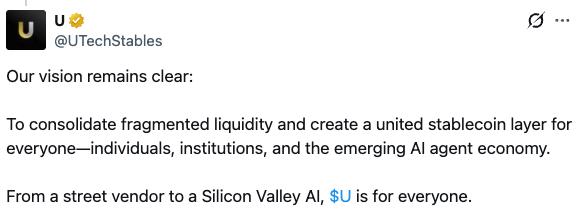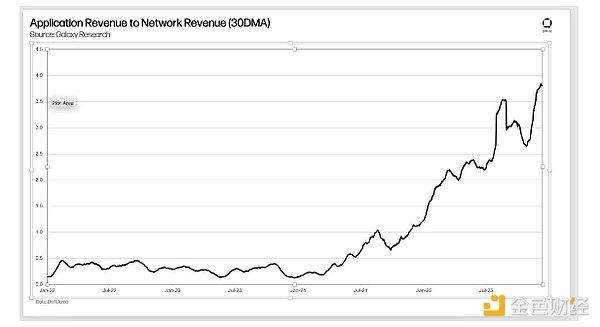On March 25, 2025 , the Trump family launched the dollar-pegged stablecoin USD1 through the World Free Finance (WLFI), which instantly sparked heated discussions in the crypto market.
As the current president of the United States, Donald Trump has transformed himself from a "skeptic" of cryptocurrency to a "supporter", and now he has brought his family directly to launch this new project. USD1 not only carries the Trump family’s business ambitions, but is also seen as a major chess move to leverage the crypto market using its political influence.
The stablecoin market has long been a battlefield for giants to dominate, with Tether (USDT) and Circle (USDC) accounting for nearly 90% of the market share. Why did the Trump family enter the market at this time? Can they break the existing pattern with USD1? More importantly, what kind of ripple effect will this "presidential-backed" stablecoin have on the crypto market?
USD1: The Trump family’s blueprint for a stablecoin
USD1 is a dollar-pegged stablecoin launched by the Trump family through World Free Finance (WLFI), which aims to provide institutional investors and sovereign investors with a "safe, compliant and transparent" digital dollar tool.
According to the official announcement of WLFI, USD1 will be 100% supported by short-term U.S. Treasury bonds, U.S. dollar deposits and other cash equivalents, ensuring that each USD1Token can be exchanged for 1 U.S. dollar at a ratio of 1:1. This design is similar to mainstream US dollar stablecoins on the market (such as USDT and USDC), but WLFI emphasizes its "institutional level" compliance and transparency in an attempt to attract large investors.
Specifically, USD1’s operating model has the following key points:
Asset Support and Custody:
USD1's reserve assets will be held by BitGo, a California-based crypto custody company. BitGo not only provides secure storage, but also provides deep liquidity and trading support for USD1 through its Prime brokerage service. WLFI said USD1’s reserves will be audited regularly by a third-party accounting firm to ensure transparency. However, as of March 25, 2025, WLFI has not yet announced the name of the specific accounting firm it will cooperate with.
Blockchain support:
USD1 will first be issued on Ethereum and Binance Smart Chain, with plans to expand the suite to other blockchain networks in the future. This choice shows WLFI's preference for mainstream public chains. Ethereum is the core of the DeFi ecosystem, and BSC also occupies an important position in the crypto market due to its low transaction fees and high throughput. According to data from Etherscan and BscScan, USD1's smart contract was deployed in early March 2025, with a total supply of more than 3.5 million US dollars, but it is not yet open for trading.
Target users:
WLFI made it clear that USD1 is not aimed at retail investors, but is designed for institutional and sovereign investors. Zach Witkoff, co-founder of WLFI, said in the announcement: "What we offer is a digital dollar stablecoin that sovereign investors and large institutions can confidently integrate into their strategies for seamless and secure cross-border transactions." This positioning shows that the Trump family hopes to enter the institutional market through USD1 and challenge the application of existing stablecoins in cross-border payments and DeFi.
Integration with traditional finance:
The design concept of USD1 emphasizes integration with traditional finance. Witkoff said USD1 "offers an advantage that algorithmic stablecoins and anonymous DeFi projects cannot offer - access to the power of DeFi with the support of the most respected names in traditional finance." WLFI also plans to collaborate with DeFi projects such as Sui, Ondo Finance, Chainlink and Aave to explore how to more closely integrate blockchain finance with traditional finance.
It is worth mentioning that USD1 is not the Trump family’s first attempt in the field of encryption. In October 2024, WLFI launched another crypto token, WLFI, and raised $550 million through two public token sales, with entities affiliated with the Trump family receiving 75% of the proceeds.
In addition, Trump and First Lady Melania launched their own memecoins before taking office. Trump's memecoin $TRUMP soared to $14 billion in market value after its launch on January 17, 2025, but then experienced a plunge of more than 80%.
Stablecoins under US regulatory storm
As an important part of the crypto market, stablecoins have attracted much attention at the U.S. regulatory level in recent years. After Trump came to power, his pro-crypto policy orientation brought new opportunities to the stablecoin industry, but also brought potential challenges. The launch of USD1 is taking place against this complex background.
Trump Administration’s Pro-Crypto Policy:
During his campaign, Trump promised to make the United States the "cryptocurrency capital" and quickly took a series of pro-crypto measures after taking office.
In January 2025, Trump signed an executive order aimed at promoting the development of the crypto industry in the United States and proposed the idea of establishing a national crypto reserve. In early March, he further announced the establishment of a U.S. Strategic Crypto Reserve including Bitcoin, Ethereum, XRP, Solana, and Cardano.
Trump's crypto promises before taking office directly drove the crypto market up, with the price of Bitcoin exceeding $107,000 by the end of 2024, up nearly 100% from before Trump's campaign.
The advancement of the stablecoin bill:
In March 2025, the U.S. Congress was considering the "Guidance and Establishment of a U.S. Stablecoin National Innovation Act." The bill passed the Senate Banking Committee on March 13 and is expected to be submitted to Trump for signature by June. The bill aims to establish a new regulatory framework for stablecoin issuers, giving them a legal status similar to that of traditional banks.
For USD1, the advancement of this bill is undoubtedly a major positive. As a Trump family project, USD1 may receive priority treatment in regulatory approval and market access. However, this has also raised concerns about potential conflicts of interest. The Trump family is directly involved in encryption projects, and the Trump administration is promoting policies that are favorable to the encryption industry. This role of "both referee and player" has been criticized by some government ethics experts and political opponents.
Regulatory challenges and market competition:
Despite policy support, USD1 still faces considerable challenges.
First, competition in the stablecoin market is extremely fierce. Tether (USDT) and Circle (USDC) have become dominant, with market share far ahead. In January 2025, the total market value of stablecoins exceeded US$200 billion, with the number of active wallets of USDT and USDC increasing by more than 50% in the past year. In contrast, as a new player, it is difficult for USD1 to quickly establish market trust and ecosystem.
Second, regulatory uncertainty remains. Although the Trump administration has a friendly attitude towards the crypto industry, stablecoins involve cross-border payments and financial stability, which may trigger additional scrutiny from agencies such as the Federal Reserve and the Treasury Department. In addition, the Trump family’s involvement may make it the focus of political games, further increasing policy risks.
USD1’s Ripple Effect
The launch of USD1 is not only another attempt by the Trump family in the field of encryption, but may also have a profound impact on the entire market:
Impact on the stablecoin market landscape:
The entry of USD1 will intensify competition in the stablecoin market. Although it is initially positioned at institutional investors, if it can successfully build trust and expand its user base, it may pose a threat to the market share of USDT and USDC. In particular, USD1, backed by the political influence of the Trump family, may attract the attention of more traditional financial institutions and sovereign funds, thereby promoting the application of stablecoins in cross-border payments and DeFi.
However, market expert Kevin Lehtiniitty pointed out: "It is easy to launch a stablecoin, but it is much more difficult to build an ecosystem with widespread adoption."
USD1 needs to face fierce competition from Tether and Circle. It remains unknown whether the Trump family will cooperate with other American companies or compete directly.
Potential impact on US dollar hegemony:
Both the Trump administration and the WLFI stressed that the launch of USD1 will help consolidate the dollar's dominant position in the global financial system. As global demand for USD stablecoins increases, USD1 may become a new tool for the digitization of the US dollar, further promoting the use of the US dollar in international trade and payments.
But at the same time, the popularity of stablecoins may also have an impact on the traditional financial system. The efficient cross-border payment capabilities of stablecoins may challenge the status of existing financial intermediaries and affect their trillions of dollars in short-term fixed income market revenue.
Overall impact on the crypto market:
The Trump family's involvement has undoubtedly injected new attention into the crypto market. The launch of USD1 may attract more traditional investors into the crypto space and push the market further into the mainstream. In addition, the Trump administration’s pro-crypto policies may stimulate the emergence of more innovative projects, further increasing the activity of the crypto market. But risks also exist.
The Trump family's involvement could fuel speculation in the market and lead to greater price volatility. $TRUMP is an example, its price has fallen by more than 80% since its peak on January 19, 2025, showing the market's speculation on its project. USD1 may also face similar risks if it fails to effectively manage market expectations.
Promotion of DeFi ecology:
One of USD1’s goals is to become an important part of the DeFi ecosystem. WLFI plans to develop a decentralized financial platform that is easy for ordinary people to use by collaborating with projects such as Aave and Chainlink. If USD1 can gain a foothold in the DeFi field, it may drive more institutional funds into DeFi, further expanding the size of this market.
summary
The Trump family's entry into the stablecoin market through USD1 is not only another attempt to expand its business empire, but also a bold layout in the political and financial fields. With its institutional positioning, compliance design and political endorsement, USD1 is expected to occupy a place in the stablecoin market. However, faced with fierce market competition and a complex regulatory environment, the future of USD1 remains uncertain.
The launch of USD1 could be an important turning point for the entire crypto market. It may not only reshape the stablecoin market, but also pave the way for further mainstreaming of the crypto industry by promoting the digitization of the US dollar and the development of DeFi. At the same time, the Trump family's involvement also brings new risks, including conflicts of interest, market speculation and regulatory uncertainty.
Whether USD1 can truly stir up the market, perhaps only time can give the answer.







